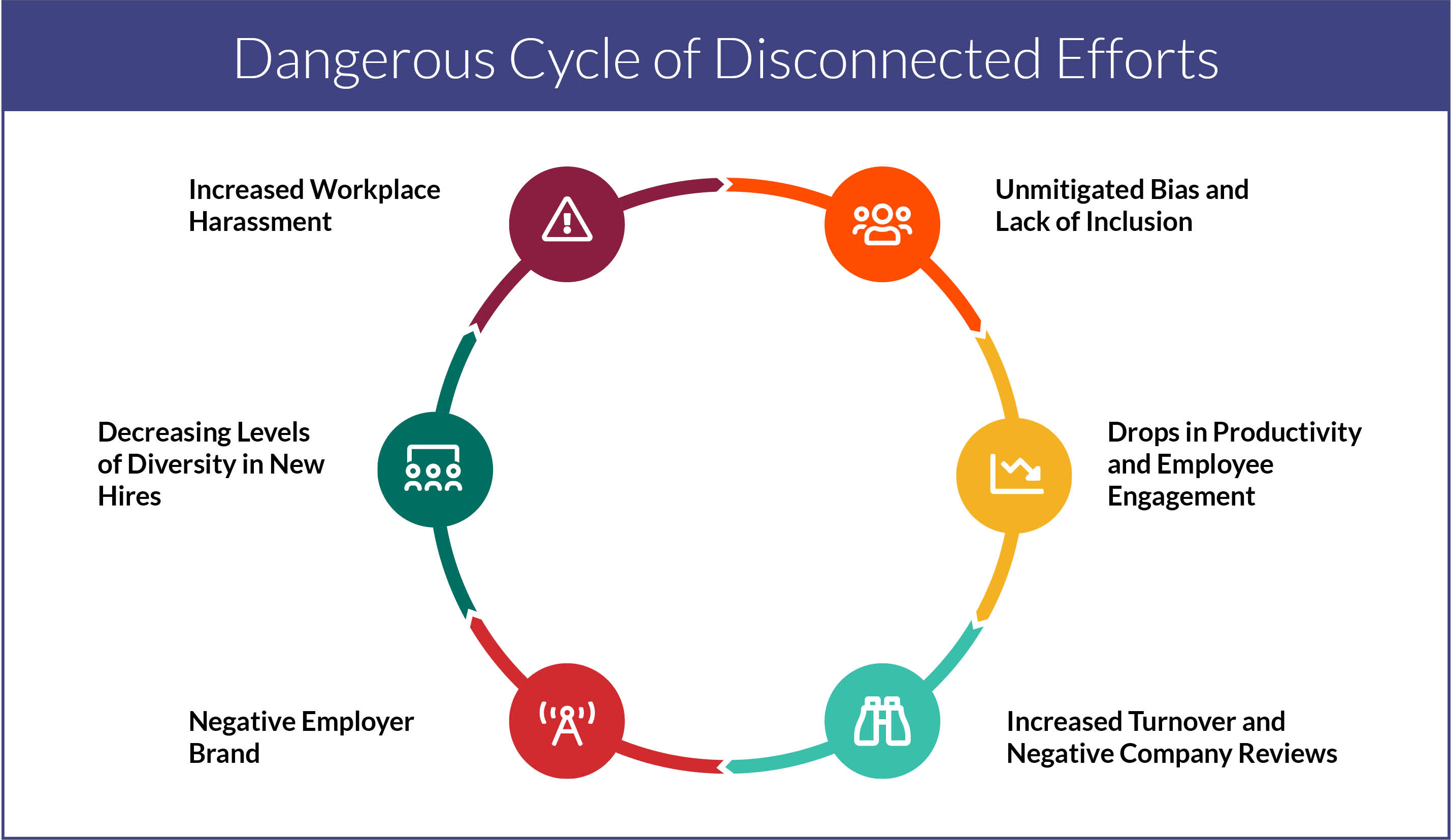Workplace Training • 9 Minute Read
How to Attract and Retain Talented Employees in 2023
How to improve employee retention by building a workplace culture where employees want to join, stay, and grow amidst the “Great Resignation"

No one knows better the tumultuous state the work world has experienced over the past year than HR professionals. As employees voluntarily left their jobs in 2021 in record-shattering numbers and hiring managers struggled to attract and retain talent at every level, organizations scrambled to find a solution to the labor shortage — and continue to do so.
To find a remedy for the Great Resignation, it’s critical to understand the root cause of why so many employees are leaving. Recently, an industry-wide survey from the MIT Sloan Management Review shed some light on challenges in attracting and retaining employees by revealing:
The #1 reason employees quit their jobs in 2021: Toxic workplace culture
- 43 million employees voluntarily quit through November 2021
- #1 business disruption in 2022 will be talent shortages, according to CEOs
- 1 in 8 jobs are predicted to remain vacant in 2022
The primary challenge in attracting and retaining employees lies in improving workplace culture.
So, what defines a toxic workplace — and, more importantly, how can you as an HR leader empower your team with the skills they need to build better workplace cultures that attract and retain talented employees?
What Defines a Toxic Workplace?
The MIT Sloan Management Review (MIT SMR) survey lists several elements that contribute to a toxic work culture:
- An organization’s failure to promote diversity, equity, and inclusion (DEI)
- Employees being treated poorly or with disrespect
- Unethical behavior
That means, to not only stay competitive but survive in 2023, it has become mission-critical for employers to ramp up their workplace culture and ethics efforts to ensure they are creating an environment where employees feel valued, included, and treated fairly.
- Going Beyond the Great Resignation Statistics
- How to Fix a Toxic Work Environment
- Promoting Diversity to Prevent Discrimination
- DEI in Recruitment & Retention
- Harassment in Hybrid Work Environments
- How to Prevent Burnout in the Workplace
Going Beyond the Great Resignation Statistics
With a record 24 million U.S. workers leaving their jobs between April and September 2021, the Great Resignation was a reaction to the prior status quo and a stark wake-up call for employers to do more, do better, or do differently.
This workforce mass exodus has happened for various reasons, among them:
- Increased desire for flexibility and work-life balance (brought on after months of working remotely)
- Resistance to return to a workplace in which employees didn’t feel safe or supported by their employer
- Employees reassessing their goals and values — and opting to do something different
Still, as the aforementioned MIT SMR data reveals, workplace toxicity remains the driving force for employees to quit their jobs — in fact, it was a 10 times stronger predictor of employee turnover than compensation. And because the labor shortage situation is predicted to worsen in 2022, employers and HR leaders will need to develop employee retention strategies that focus on creating an inclusive, workplace culture where employees feel safe, included, and valued.
How to Fix a Toxic Work Environment
In 2019, a survey from EVERFI and the HR Research Institute revealed that toxic cultures and negative stress are common in the workplace — in fact, 54% of respondents reported negative stress was prevalent in their workplaces.
But with 40% of employees saying their employers haven’t done enough to address employee mental health — and with toxic workplaces being the #1 reason employees left their jobs during the Great Resignation — now more than ever, it is critically important for organizations to address workplace toxicity.
Traditional notions of “workplace health and safety” have always focused on physical health, vis-à-vis injury and illness. Last year, the concept of workplace health understandably focused on issues around COVID, like vaccines, masking, office closures, and safety protocols.
As employee wellbeing is key in attracting, recruiting and retaining top talent, in 2023, many employers will need to broaden their focus to rethink — and redefine — what it means to have a healthy, safe workforce. A more holistic approach to creating a non-toxic work environment that minimizes stress and supports holistic employee wellbeing may include addressing:
- Mental wellness, stress, and burnout (along with the need for accommodations)
- Drug and alcohol misuse
- Environmental stressors that affect psychological safety and wellbeing, including toxic managers and work environments, microaggressions, and online harassment
- Employee financial stress
- Upticks in online harassment
When employees’ physical, mental, social, and emotional well-being are supported, it can lead to a workforce that’s more engaged, more productive, and more creative. Having a healthy workforce can also help reduce health plan costs and absenteeism, which can improve business outcomes.
Promoting Diversity to Prevent Discrimination
Like any worthwhile employee retention strategy, promoting diversity, and inclusion consists of many parts — and addressing discrimination is one of those parts.
Research suggests a lack of diversity and inclusion at work can promote harassment (which is a form of discrimination), and that discrimination is more likely to happen in a workplace with a lack of diversity.
Organizations that don’t make DEI a priority may be surprised by the number of internal harassment claims they face. The issues of harassment and discrimination (H&D) and DEI are inexorably connected. Focusing your company’s efforts on just one without the other, or failing to coordinate the two, will increase your risks of harassment and discrimination and undermine your efforts to create a healthy, inclusive workplace in 2022.

The disconnect between DEI and H&D is often seen by the separate training efforts on these issues. To bridge this divide, consider taking a coordinated training approach.
Creating a cohesive learning and development strategy that focuses on both types of training broadly reinforces a workplace culture of respect, civility, and belonging — rather than separate vehicles to focus on narrower, distinct, and siloed subtopics.
Ramping up workplace culture efforts demonstrates to employees they (and their contributions) are valued and respected. Employers that prioritize employee support, recognition (monetary and non-monetary), inclusion, and belonging will be employers of choice in a tough job market.
DEI in Recruitment & Retention
After many organizations made public commitments to promote DEI in 2020, 2021, and 2022, job seekers and employees are looking for sustained action and results. The majority of Millennials — roughly 75% of the workforce — want to work for companies that actively foster inclusion.
They want to see increased representation, and continued conversations and training around diversity, bias, and microaggressions.
This means in 2023, employers will need to train or continue to train their leaders and workforce on how to be inclusive, how to build diverse teams, and ways to prevent bias.
But DEI isn’t something HR or DEI professionals can (or should) do alone — it’s critical to teach employees how to act as an ally and address disrespectful behavior. Teach leaders how to lead inclusively and support DEI across all facets of the employee experience, from hiring to coaching to promotion to termination.
Read: Don’t Let the Great Resignation Deter Your DEI Efforts
Harassment in Hybrid Work Environments
As hybrid work environments became the status quo, one unfortunate trend that has come out of distributed workforces — and is expected to escalate in 2023 unless employers take action — is an uptick in online harassment. In fact, 25% of employees have reported they’ve experienced more gender-based harassment since they started working remotely.
This is likely caused by the casualness in online environments and the lack of witnesses when employees are online versus in-person in a room with people.
In 2023, the ability to attract and retain talented employees will rely on shifting the focus to anti-harassment training, especially among their dispersed workforce.
Is Your Sexual Harassment Training Doing More Harm than Good?
Explore key concepts of identity, power, privilege, and communication for college students
How to Prevent Burnout in the Workplace?
As organizations continue to navigate the Great Resignation, talent shortages can be disruptive to everything they do, including the ability to:
- Sell products or services
- Service customers
- Maintain production
But impacts to sales and revenue only scratch the surface. When remaining employees are stretched thin due to labor shortages, they may experience fatigue and sometimes take shortcuts, which can lead to mistakes, accidents, and lapses in ethics.
However, implementing tactics commonly found in harassment and inclusion training programs can help reduce burnout at your organization.
Effective H&D and DEI Training Strategies
- Aligning behavioral expectations with a culture of respect, civility, and inclusion
- Developing empathy for others and perspective-taking
- Recognizing microaggressions, “gray area” behaviors, and other warning signs that can lead to harassment or discrimination
- Equipping employees to take action when they witness concerning situations through bystander intervention techniques
- Building conflict management skills for employees
- Encouraging learners to set personal goals
- Communicating the mission-critical role managers play in modeling equity, inclusion, respect and keeping employees safe
To reduce burnout, focus on training that empowers your employees to build a better workplace culture where employees feel safe, welcomed, and treated fairly.
Getting Started with Harassment and Inclusion Training to Improve Employee Retention
We applaud any company’s efforts to provide DEI training for employees. But it’s also important to go beyond a once (or once a year) approach to make sure training sticks and actually makes a difference.
If you’re wondering where to begin, you’re not alone if this feels overwhelming. So here are three key areas to focus on as a starting point:
- Promoting equity and belonging by incorporating diversity training best practices in recruiting, hiring, mentorship, and promoting employees, as well as in managing inclusive teams.
- Preventing harassment and discrimination to help build a positive workplace culture where employees respect one another’s differences.
- Expanding your organization’s approach to keeping employees healthy, as workplace health and wellness is key in recruiting and retaining talent.
Rather than wasting valuable company resources on ineffective diversity programs, take the time to focus your efforts and embrace proven employee retention strategies that will have a demonstrated impact.
Harassment and Inclusion Training Helps You Recruit, Attract, and Retain Top Talent
You know harassment and inclusion training is more than just a nice-to-have — it’s non-negotiable in 2023 to help combat the Great Resignation.
EVERFI’s workplace training packages help you empower your employees with the skills they need to build better workplace cultures through impactful, engaging content that’s backed by compliance expertise, all delivered on an easy-to-use platform. Get a firsthand look at our online workplace compliance and culture training packages with a free demo.
